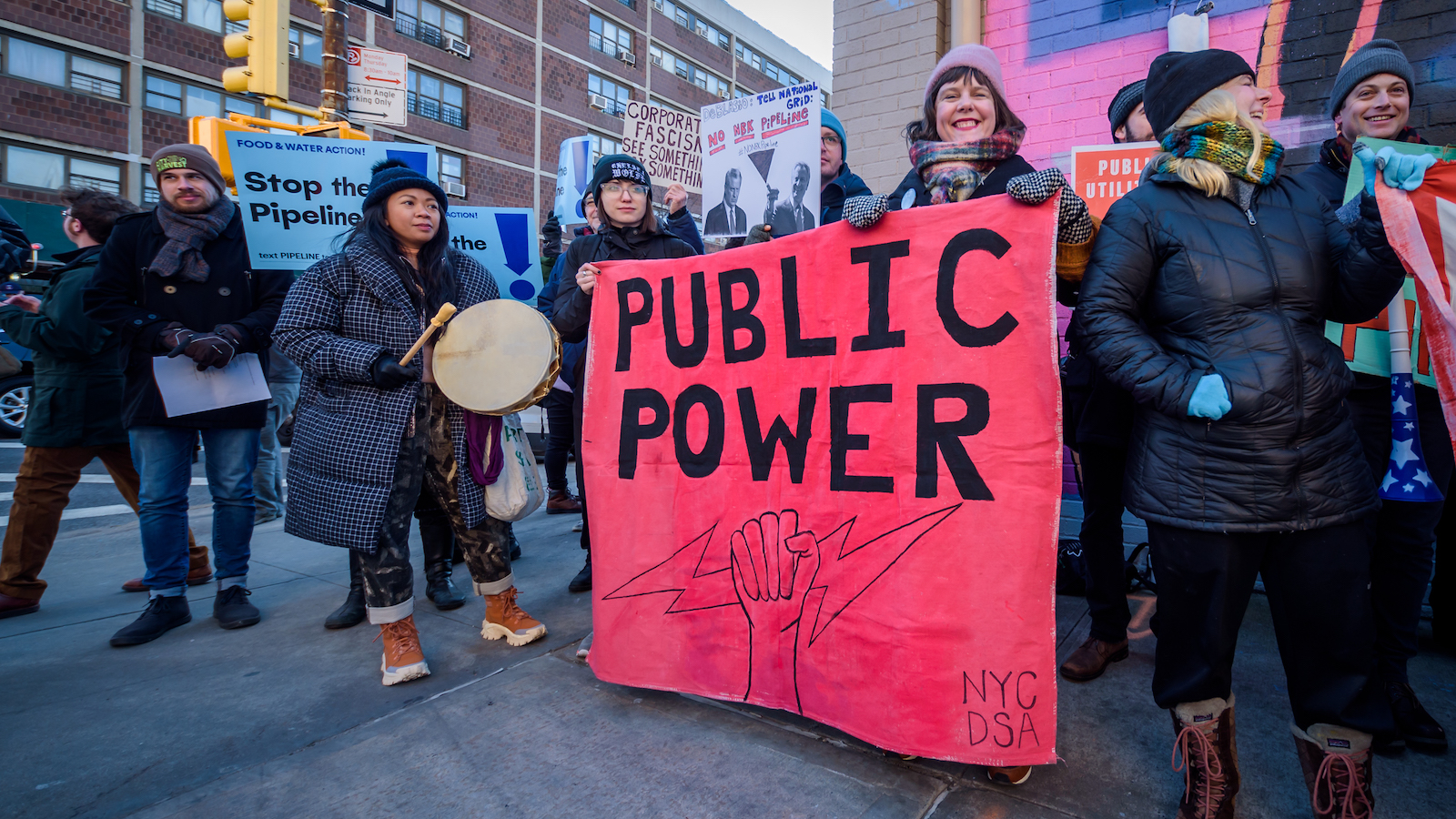On Monday night, more than 200 activists tuned into a “rapid response” Zoom call organized by the New York chapter of the Democratic Socialists of America, or DSA. It was a chance to regroup after a rollercoaster week where it looked as though a DSA-authored climate bill might make it through the state legislature.
The bill, called the Build Public Renewables Act, soared through the New York State Senate last Wednesday. After a zealous eleventh-hour push by grassroots organizers to garner support in the Assembly, it appeared to have the 76 “yeas” required to send it to the governor’s desk, and then some. But on Saturday, Carl Heastie, the Democratic speaker of the Assembly, brought the year’s legislative session to a close without ever giving his colleagues a chance to vote on it.
“We need to consider this as the beginning of our movement as opposed to the end,” Zohran Mamdani, a state assembly member from Queens, said on the Monday call.
Supporters of the bill painted it as a climate package that would have sped up the pace at which renewable energy comes online in New York state. But beyond that, it would have opened the door for a larger role for publicly owned power, testing whether giving the government more ownership over the clean energy transition can deliver in ways that the private market hasn’t.
It’s an idea that’s been gaining ground with climate advocates around the country as they grow increasingly frustrated that energy systems are not moving away from fossil fuels quickly enough. They argue that publicly owned power companies, which are not beholden to shareholders and do not have the same profit motive as their private counterparts, can enable a transition that’s faster, more affordable, more worker-friendly, and more accountable to communities.
In Maine, for example, where the state’s largest private utility has been investigated for mismanagement, is generally reviled by customers, has slowed down utility-scale solar projects, and has fought rooftop solar, campaigners want the state to buy it out and replace it with a nonprofit, consumer-owned utility. Elsewhere, cities like Boulder, Colorado, and Chicago have attempted takeovers at the local level. But in New York, organizers took a slightly different tack, aiming to expand the powers of an existing public utility, the New York Power Authority, or NYPA, in a first step toward democratizing the energy system while helping the state meet its ambitious climate and environmental justice goals.
“The state is not on pace to meet the goals of the Climate Leadership and Community Protection Act,” the state’s landmark 2019 climate law, “because the state’s goals are completely predicated on private market actors,” said Robert Carroll, a State assembly member and the bill’s lead sponsor, before the close of the legislative session. “So what this does is makes NYPA a larger actor in that universe, it adds another competitor. And when you add another competitor, I think you’re gonna see projects that otherwise would not have been built getting built.”
NYPA is the largest state-owned power utility in the United States and currently provides nearly 25 percent of New York’s electricity. Its customers are primarily commercial and institutional buyers like hospitals, colleges, businesses, local governments, and public housing authorities, but it also sells power to private utilities like Con Edison through the wholesale electricity market.
Seventy percent of the power it generates comes from hydroelectric dams. But it also owns or contracts with more than a dozen power plants that run on oil and natural gas. Under the most recent version of the Build Public Renewables Act — the one that almost passed — NYPA would have to retire those plants and transition to 100 percent clean energy by 2030. The bill also would expand NYPA’s customer base, requiring the utility to serve all state-owned buildings by 2030 and all municipally owned buildings by 2035, meaning it would have to build enough renewables to replace its fossil fuel plants and then build some more. Under current law, NYPA’s ability to build and operate new renewable projects is severely restricted — the bill would give it broader authority to do so.
“Why would you not use the power of NYPA?” said Johanna Bozuwa, executive director for the nonprofit Climate and Community Project, who authored a report that supported the bill. “You have a sleeping giant in New York state that could be used to deploy renewable energy. We need to be using as many levers as we can, and to take NYPA out of that calculation, I think would be a loss.”

Whether New York is currently on track to meet its legally mandated target of 70 percent renewable energy by 2030 is disputed. On Thursday, while activists were making calls to get the bill on the floor in the Assembly, Governor Kathy Hochul announced 22 new utility-scale solar contracts. According to the press release, the state now has more than 120 wind and solar projects under development that it says could eventually get New York to 66 percent renewable electricity.
But activists are skeptical that the state’s existing system is working, pointing to the fact that New York’s grid is currently only at 4 percent wind and solar (and about 25 percent hydropower). “There’s a lot of new announcements, but shovel hitting ground and actually building out the renewables isn’t happening at the scale we need right now,” said Aaron Eisenberg, an organizer with Public Power NY, a coalition that championed the bill. The state’s new Office of Renewable Energy Siting, which was created to speed up permitting, has only approved four projects since it began reviewing them in early 2021.
The Public Power NY coalition believes NYPA would be able to build projects more quickly than private developers because siting and permitting could be streamlined and new community engagement processes laid out in the bill are designed to tamp down the opposition that many private developers have faced. Advocates also argue that renewable energy projects developed by NYPA would be able to inject cheaper power into New York’s electricity system than private developers because it has access to cheap capital to build new projects through the municipal bond market and does not need to turn a profit.
But there are other challenges facing renewable development in New York, according to Anne Reynolds, the executive director of Alliance for Clean Energy New York, a wind and solar industry group that opposed the bill. She said renewable developers are facing delays connecting to the grid, tax agreement negotiations, supply chain problems, and a need for new transmission lines to bring the new clean power to customers. “These are real problems, and the Build Public Renewables Act doesn’t solve — or even help — with any of them,” she said.

Ultimately, the bill would be an experiment — not a full transition to public power, but a test of whether NYPA could actually build things any faster or cheaper. Plenty of experts and observers doubt the strategy. Big green nonprofits that are active in New York climate politics like Sierra Club and the Natural Resources Defense Council were neutral on the bill.
But with enthusiasm for public power growing around the country, Bozuwa thinks that passing the Build Public Renewables Act would help other campaigns gather steam. “The fact that it even got this close is a sea change when it comes to the types of energy policies that are being put forward,” she said.
On Monday, Speaker Heastie, who blocked the vote on the bill, put out a statement acknowledging its broad support (though he also asserted it was not enough to pass the bill, despite proponents’ claim of the contrary). In a move with little precedent, he is convening a hearing on July 28 to examine aspects of the bill including “capacity to meet goals, potential costs of needed infrastructure, and impacts on consumers and taxpayers, acquisition costs.” (Bill hearings typically occur before the legislative session ends, not after.)
On Monday night, Public Power NY put out a statement calling on Heastie to go a step further and convene a special session the week after the hearing to pass the Build Public Renewables Act. “While that would be unprecedented, so is calling this hearing, and so is the climate crisis,” it said.
If not, the activists plan to continue to pressure elected officials in the upcoming Democratic primaries and to bring the bill to the floor again next year.



